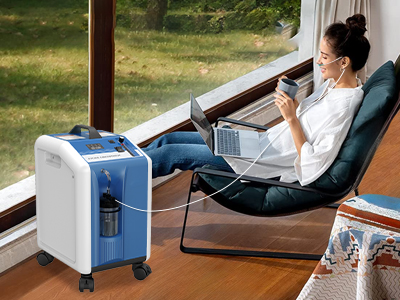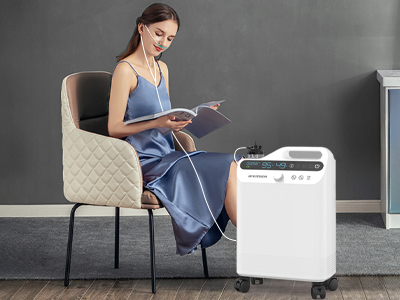18 Feb 2024
Before selecting an oxygen concentrator, individuals should undergo a thorough medical evaluation to determine their oxygen therapy needs. This typically involves consulting with a healthcare professional who can assess the severity of the respiratory condition and prescribe the appropriate oxygen therapy regimen.
The oxygen flow rate required by an individual depends on various factors, including the underlying medical condition, activity level, and oxygen saturation levels. Understanding these factors is essential for determining the optimal oxygen flow rate to ensure adequate oxygen delivery to the body's tissues.

Types of Oxygen Concentrators
A. Continuous Flow vs. Pulse Dose
Oxygen concentrators are available in two primary types: continuous flow and pulse dose. Continuous flow concentrators deliver a constant flow of oxygen, making them suitable for individuals who require oxygen therapy at all times. Pulse dose concentrators, on the other hand, deliver oxygen in pulses or bursts, which is ideal for individuals with varying oxygen needs based on activity level.
B. Portable vs. Stationary
Another consideration when choosing an oxygen concentrator is whether to opt for a portable or stationary model. Portable concentrators are lightweight and compact, allowing users to maintain their mobility and independence. Stationary concentrators, on the other hand, are designed for use at home and provide continuous oxygen flow for individuals who do not need to travel frequently.
Technical Specifications and Features
A. Oxygen Purity and Delivery Accuracy
The oxygen purity and delivery accuracy of an oxygen concentrator are critical factors to consider. High oxygen purity ensures that the user receives the prescribed oxygen concentration, while accurate delivery ensures consistent therapy delivery, minimizing the risk of over or under-oxygenation.
B. Noise Level and Size
The noise level and size of an oxygen concentrator can impact user comfort and convenience. Models with low noise levels are preferable, especially for nighttime use, while compact designs are ideal for individuals with limited space or those who frequently travel.
Battery Life and Power Options
A. Battery Life and Portability
For individuals who require portable oxygen therapy, battery life is a crucial consideration. Longer battery life allows users to stay active for extended periods without needing to recharge or replace batteries frequently, enhancing portability and convenience.
B. Power Source Compatibility
When choosing an oxygen concentrator, it's essential to consider its compatibility with different power sources. Models that can be powered by AC and DC sources, as well as batteries, offer greater versatility and flexibility in usage, ensuring uninterrupted oxygen therapy even during power outages or travel.

Comfort and User-Friendly Features
A. Ergonomic Design and Adjustability
An oxygen concentrator with an ergonomic design and adjustable settings ensures user comfort during prolonged use. Features such as adjustable straps, padded carrying handles, and customizable settings enhance user experience and satisfaction.
B. Intuitive Controls and Maintenance
User-friendly controls and easy maintenance features are essential for ensuring a hassle-free experience with an oxygen concentrator. Intuitive controls simplify operation, while easy-to-access maintenance components make routine cleaning and servicing convenient for users.
Brand Reputation and Reviews
A. Researching Reliable Brands
When purchasing an oxygen concentrator, it's essential to research reputable brands known for producing high-quality, reliable devices. Brands with a proven track record of manufacturing durable and effective oxygen concentrators instill confidence in users regarding product performance and reliability.
B. Reading User Reviews
Reading user reviews provides valuable insights into real-life experiences with specific oxygen concentrator models. By considering feedback from other users, individuals can make informed decisions and choose a device that best meets their needs and expectations.
Cost Considerations and Financial Assistance
A. Upfront Cost vs. Long-Term Value
While the upfront cost of an oxygen concentrator is a significant consideration, it's essential to evaluate the long-term value of the investment. Factors such as durability, performance, and warranty coverage contribute to the overall value proposition of a device, ensuring that it meets the user's needs over time.
B. Insurance Coverage and Financing Options
Exploring insurance coverage and financing options can help offset the cost of purchasing an oxygen concentrator. Many insurance plans offer coverage for durable medical equipment, including oxygen concentrators, while financing options such as payment plans or medical loans provide additional flexibility for managing upfront expenses.
Conclusion
A. Summary of Key Points
In conclusion, selecting the right oxygen concentrator involves careful consideration of various factors, including oxygen therapy needs, device specifications, comfort features, and cost considerations. By taking a comprehensive approach and conducting thorough research, individuals can choose a device that meets their specific requirements and enhances their quality of life.
Keywords: oxygen concentrator
Originally published 18 Feb 2024, updated 18 Feb 2024.